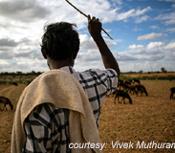In inland China, rice, rather than fish, is the major pathway for Methylmercury exposure
Fish consumption is regarded as the primary pathway of methylmercury (MeHg) exposure for most people in the world. However, in the inland regions of China, most residents eat little fish, but they live in areas contaminated with mercury (Hg). To investigate salient MeHg exposure for the general adult population in Guizhou, Zhang et al. (p. 1183) selected four locations representing typical rural areas in Guizhou Province, where the diet is primarily locally grown agricultural products: Wanshan (Hg mining and smelting activities), Qingzhen (coal-fired power plant), Weining (artisanal zinc smelting activities), and Leigong Natural Reserve (no direct Hg contamination sources). The probable daily intake (PDI) of MeHg was considerably higher in people living in Wanshan than in the other areas; approximately 34% of Wanshan residents exceeded the reference dose for MeHg established by the U.S. Environmental Protection Agency. The MeHg PDI in the other three locations were all below the reference dose. In all four areas, rice consumption accounted for 94–96% of the MeHg PDI. The results of this study underscore the need to consider dietary sources of MeHg in risk assessment and in developing approaches for risk prevention and mitigation.







